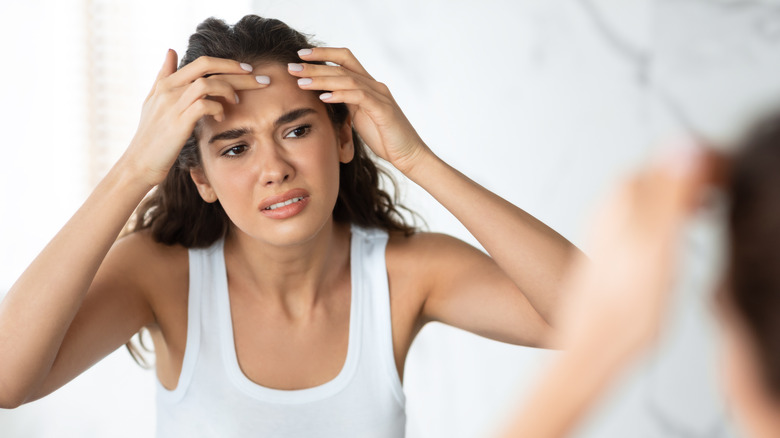Your Favorite Accessories Might Be Giving You Forehead Acne
Acne is never fun. Whether you suffer from the skin condition regularly or deal with unwanted spots that show up right before a special occasion, having acne on your face especially, can be a major confidence-killer.
You may have heard of acne face mapping, which basically tells you what the pimples in different parts of your face mean and how to treat them. The forehead is an area of concern for some. Acne on the forehead can be caused by hair care products, excessive sweating, stress, and even hormones. Touching your forehead often can cause breakouts as well. But did you know that some of your favorite accessories could be to blame too?
Often referred to as "acne mechanica" by dermatologists, this is a type of acne that is caused primarily by tight clothing or accessories that cause friction on your skin. Acne mechanica isn't restricted just to your forehead though. It can turn up in other areas like your shoulders or back (because of tight bra straps) or your buttocks (again as a result of restrictive clothing). When it comes to your forehead, think of sportswear like caps, helmets, headbands, and even your favorite bandana that you like to wear low on your head. According to board-certified dermatologist Craig Kraffert (via Byrdie), "This is particularly problematic with protective headgear such as football and cycle helmets, and is one tradeoff for [those with acne] engaged in these sports."
Sleeping with an eye mask can cause forehead acne too
Are you a fan of sleeping with an eye mask? You may want to rethink your favorite bedtime accessory, especially if you're acne-prone, shared licensed esthetician Carmen Popa on TikTok. Eye masks may feel like a stretch but since they "sit directly on the skin" as shared by Popa, they cannot be ruled out as irritants, even if you remember to wash them often. "If you're doing everything right for your skin but [it's] not clearing up, it could be acne mechanica, especially if you're sleeping in an eye mask," added Popa.
With forehead acne and accessories, friction isn't the only reason. Hats, headbands, bandanas, and helmets can also trap heat and sweat that carries bacteria.
If you're someone who likes to work out often and hit the gym two to three times a week, you might want to be careful about any headgear you wear repeatedly. Hot or humid weather while working out can make you sweat more profusely and anything you're wearing on your head could be trapping the dampness and eventually causing you to break out.
How to handle forehead acne caused by accessories
The first step would be to remove the item that's causing the irritation. Allowing the skin on your forehead to breathe is important, as noted in Healthline. The next step is to turn to over-the-counter acne treatments like gentle cleansers that either have benzoyl peroxide or salicylic acid in them. Topical vitamins like retinoids and nicotinamide work too. Board-certified dermatologist, Purvisha Patel told Byrdie that when it comes to retinoids, she'd recommend Differin or Retin-A. "Differin is an over-the-counter acne medication that promotes the unclogging of pores. A prescription variant would be Retin-A, which helps open the clogged pore and the hardened oil come to the surface."
For particularly stubborn forehead acne, see a dermatologist. They might recommend topical antibiotics or other treatments to clear up your skin.
Prevention is also a good way to tackle acne mechanica. It might be time to take a look at your hats, caps, headbands, and favorite bandana. Are they clean when you wear them? Are they too tight? Do you wear them too often? If a helmet is part of your everyday life, consider taking a break from wearing them. Also, don't wear them for longer than needed, especially in warm weather. When you're done playing a sport or riding your bicycle, remove the gear and wash your face soon after. You don't have to swear off accessories altogether. You might just have to be a little more mindful about how you wear them.

